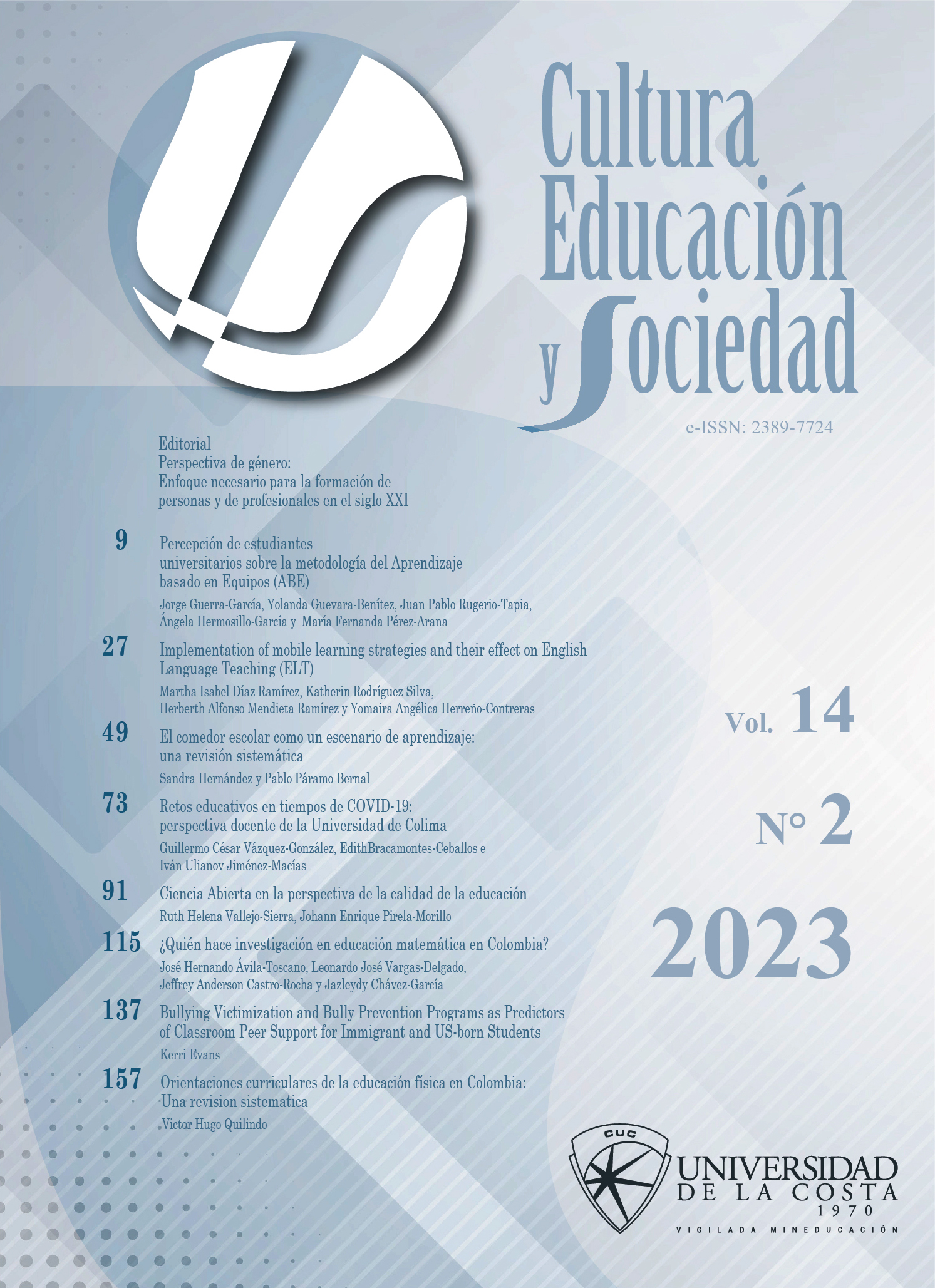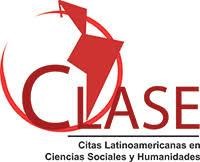Programas de Victimización por Bullying (Intimidación) y Prevención de Bullying Intimidación como Predictores del Apoyo entre Compañeros en el Aula para Estudiantes Inmigrantes y Nacidos en los Estados Unidos
DOI:
https://doi.org/10.17981/cultedusoc.14.2.2023.07Palabras clave:
Estudiante, Inmigrante, Bullying, Nivel de apoyo de los compañerosResumen
Introducción: En promedio, uno de cada cuatro estudiantes en las escuelas de los Estados Unidos son parte de familias inmigrantes, y la escuela es el lugar principal donde se relacionan con sus compañeros nacidos en los Estados Unidos. Su capacidad para prosperar en el aula puede verse afectada, tanto por el acoso como por el apoyo de sus compañeros y maestros. Objetivo: Este documento buscó comprender las relaciones entre los programas de prevención de bullying y el personal de salud mental de escuelas en el apoyo de compañeros en el aula, señalando las diferencias entre los estudiantes inmigrantes y los nacidos en los Estados Unidos. Metodología: Los datos provienen de 7 881 estudiantes de quinto a décimo grado de la encuesta transversal The Health Behavior in School Children (HBSC). Stata se utilizó para ejecutar estadísticas descriptivas, pruebas t y un Modelo Lineal Jerárquico (HLM) para examinar la medida en qué los diferentes apoyos, victimizaciones y demografía influyen en el nivel de apoyo de los compañeros que los estudiantes sienten en el aula. Resultados y discusión: Los resultados indican que no hay diferencia en los niveles de apoyo de los compañeros, entre los estudiantes inmigrantes y los nacidos en los Estados Unidos. Sin embargo, la influencia de la victimización interpersonal por bullying tuvo una relación negativa con el apoyo entre compañeros, tanto para estudiantes nacidos en Estados Unidos como para inmigrantes, a través de múltiples modelos. Conclusiones: Las implicaciones sugieren más investigación sobre el tema y también más defensa de los programas de prevención del bullying que son dirigidos por pares e intencionalmente dan cuenta de los estudiantes inmigrantes.
Descargas
Citas
AECF. (2021, october 21). Who are children in immigrant families? AECF. https://www.aecf.org/blog/who-are-the-children-in-immigrant-families
Attar-Schwartz, S., Mishna, F. & Khoury-Kassabri, M. (2017). The Role of Classmates’ Social Support, Peer Victimization and Gender in Externalizing and Internalizing Behaviors among Canadian Youth. Journal of Child & Family Studies, 28(9), 2335–2346. https://doi.org/10.1007/s10826-017-0852-z
Attia, M., Staton, A., Evans, A. & Tang, S. (2023). Supporting Immigrant Students in Schools: A Qualitative Investigation. Journal of Child & Adolescent Counseling, 9(1), 34–49. https://doi.org/10.1080/23727810.2023.2168361
Barillas-Chón, D. (2010). Oaxaqueño/a students’ (un)welcoming high school experiences. Journal of Latinos and Education, 9(4), 303–320. https://doi.org/10.1080/15348431.2010.491043
Beaman, L. (2011). Social networks and the dynamics of labour market outcomes: Evidence from refugees resettled in the US. Review of Economic Studies, 79(1), 128–161. https://doi.org/10.2307/41407047
Birman, D., Weinstein, T., Chan, W. & Beehler, S. (2007). Immigrant youth in U.S. schools: Opportunities for prevention. The Prevention Researcher, 14(4), 14–17. https://eric.ed.gov/?id=EJ793964
Booi, Z., Callahan, C., Fugere, G., Harris, M., Hughes, A., Kramarczuk, A., Kurtz, C., Reyes, R. & Swaminathan, S. (2016). Ensuring every undocumented student succeeds: A report on access to public education for undocumented children. Georgetown Law Human Rights Institute. https://www.law.georgetown.edu/human-rights-institute/scholarship/scholarship/fact-finding-project/ensuring-every-undocumented-studentsucceeds-a-report/
Chiu, M., Pong, S-l., Mori, I. & Chow, B. (2012). Immigrant students’ emotional and cognitive engagement at school: A multilevel analysis of students in 41 countries. Journal of Youth and Adolescence, 41(11), 1409–1425. https://doi.org/10.1007/s10964-012-9763-x
Correa-Velez, I., Gifford, S. & Barnett, A. (2010). Longing to belong: Social inclusion and wellbeing among youth with refugee backgrounds in the first three years in Melbourne, Australia. Social Science & Medicine, 71(8), 1399–1408. https://doi.org/10.1016/j.socscimed.2010.07.018
Crea, T., Lopez, A., Hasson, R., Evans, K., Palleschi, C. & Underwood, D. (2018). Unaccompanied migrant children in long term foster care: Identifying needs and best practices from a child welfare perspective. Children & Youth Services Review, 92, 56–64. https://doi.org/10.1016/j.childyouth.2017.12.017
Devonald, M., Jones, N. & Yadete, W. (2021). Addressing educational attainment inequities in rural Ethiopia: Leave no adolescent behind. Development Policy Review, 39(5), 740–756. https://doi.org/10.1111/dpr.12523
Evans, K., Perez-Aponte, J. & McRoy, R. (2019). Without a paddle: Barriers to school enrollment procedures for immigrant students and families. Education and Urban Society, 52(9), 1283–1304. https://doi.org/10.1177/0013124519894976
Feng, D., Zhang, X. & Cao, W. (2022). School adjustment and bullying of Chinese leftbehind children: Mediating role of social support. Social Behavior & Personality: An International Journal, 50(12), 1–9. https://doi.org/10.2224/sbp.12070
Hanley, J., Al Mhamied, A., Cleveland, J., Hajjar, O., Hassan, G., Ives, N., Khyar, R. & Hynie, M. (2018). The social networks, social support and social capital of Syrian refugees privately sponsored to settle in Montreal: Indications for employment and housing during their early experiences of integration. Canadian Ethnic Studies, 50(2), 123–148. https://doi.org/10.1353/ces.2018.0018
Ham, S.-H., Yang, K.-E. & Cha, Y.-K. (2017). Immigrant integration policy for future generations? A cross-national multilevel analysis of immigrant-background adolescents’ sense of belonging at school. International Journal of Intercultural Relations, 60, 40–50. http://dx.doi.org/10.1016/j.ijintrel.2017.06.001
Harel-Fisch, Y., Walsh, S., Fogel-Grinvald, H., Amitai, G., Pickett, W., Molcho, M., Due, P., de Matos, M. & Craig, W. (2011). Negative school perceptions and involvement in school bullying: A universal relationship across 40 countries. Journal of Adolescence, 34(4), 639–652. https://doi.org/10.1016/j.adolescence.2010.09.008
Hondagneu-Sotelo, P. (2017). Place, nature and masculinity in immigrant integration: Latino immigrant men in inner-city parks and community gardens. NORMA International Journal for Masculinity Studies, 12(2), 112–126. https://doi.org/10.1080/18902138.2017.1341450
Hox, J., Moerbeek, M. & Van de Schoot, R. (2017). Multilevel Analysis: Techniques and Applications (3 ed.). Routledge. https://doi.org/10.4324/9781315650982
Iannotti, R. (2013). Health Behavior in School-Aged Children (HBSC), 2009-2010 (ICPSR 34792). Inter-university Consortium for Political and Social Research. https://doi.org/10.3886/ICPSR34792.v1
Inchley, J., Currie, D., Budisavljevic, S., Torsheim, T., Jåstad, A., Cosma, A., Kelly, C., Arnarsson, Á., Barnekow, V. y Weber, M. M. (2018). HSBC International Coordinating Centre Child & Adolescent Health Research Unit. HSBC. https://hbsc.org/publications/reports/spotlight-on-adolescent-health-and-well-being/
John, A., Lee, S., Puchades, A., Del Pozo-Baños, M., Morgan, K., Page, N., Moore, G. & Murphy, S. (2023). Self-harm, in-person bullying and cyberbullying in secondary school-aged children: A data linkage study in Wales. Journal of Adolescence, 95(1), 97–114. https://doi.org/10.1002/jad.12102
Kim, H. & Suárez-Orozco, C. (2014). The Language of Learning: The Academic Engagement of Newcomer Immigrant Youth. Journal of Research on Adolescence, 25(2), 229–245. https://doi.org/10.1111/jora.12130
Kreft, I. & De Leeuw, J. (1998). Introducing multilevel modeling. Sage. https://doi.org/10.4135/9781849209366
Ma, P-W., Torres, A. & Akoto, M. (2023). Feasibility, acceptability, and preliminary findings of a school-based intervention for recently arrived immigrant middle-school students. Psychology in the Schools, 60(6), 2072–2089. https://doi.org/10.1002/pits.22861
Markham, L. (2012). Mentoring for resettled youth. Forced Migration Review, (40), 33– 33. https://www.fmreview.org/young-and-out-of-place/markham
Martín-Pérez, Á. de L. & Gascón-Cánovas, J. (2021). The Impact of the Magnitude of the Group of Bullies on Health-Related Quality of Life and Academic Performance Among Adolescents. Child Psychiatry & Human Development, 54(3), 796–805. https://doi.org/10.1007/s10578-021-01290-8
Maynard, B., Vaughn, M., Salas-Wright, C. & Vaughn, S. (2016). Bullying victimization among school-aged immigrant youth in the United States. Journal of Adolescent Health, 58(3), 337–344. https://doi.org/10.1016/j.jadohealth.2015.11.013
Nakman, S., Nurulwahida, A. & Busthami Nur, A. (2023). Level of self-esteem: Is there any difference among physical, verbal, anti-social, and cyber bullies? International Journal of Evaluation & Research in Education, 12(1), 157–163. https://doi.org/10.11591/ijere.v12i1.22687
NCES. (2020). Report on Indicators of School Crime and Safety: 2020. NCES. https://nces.ed.gov/pubsearch/pubsinfo.asp?pubid=2021092
Olweus, D. (1993). Bullying at school: what we know and what we can do. Blackwell Publishing.
Ostrander, J., Melville, A., Bryan, J. & Letendre, J. (2018). Proposed modification of a school-wide bully prevention program to support all children. Journal of School Violence, 17(3), 367–380. https://doi.org/10.1080/15388220.2017.1379909
Reynolds, A. & Crea, T. (2017). The integration of immigrant youth in schools and friendship networks. Population Research and Policy Review, 36, 501–529. https://doi.org/10.1007/s11113-017-9434-4
Rodriguez, S., Roth, B. & Villareal, L. (2020). School social workers as Nepantleras in equity work for immigrant students: A conceptual exploration. Social Service Review, 94(4), 748–780. https://doi.org/10.1086/712044
Rossiter, M. & Rossiter, K. (2009). Diamonds in the rough: Bridging gaps in supports for at-risk immigrant and refugee youth. International Migration & Integration, 10, 409–429. https://doi.org/10.1007/s12134-009-0110-3
Roth, B. (2015). Making Connections in Middle-Class Suburbs? Low-Income Mexican Immigrant Young Men, Social Capital, and Pathways to High School Graduation. Journal of Immigrant & Refugee Studies, 13(4), 321–338. https://doi.org/10.1080/15562948.2014.970321
Roy-Campbell, Z. (2012). Meeting the Needs of English Learners. Journal of Adolescent & Adult Literacy, 56(3), 186–188. https://doi.org/10.1002/JAAL.00125
Sidanius, J. & Pratto, F. (1999). Social dominance: An intergroup theory of social hierarchy and oppression. Cambridge University Press. https://doi.org/10.1017/CBO9781139175043
Sidanius, J. & Pratto, F. (2011). Social Dominance Theory. In Van Lange, P., Kruglanski, A. & Higgins, E. (Eds.), Handbook of theories of social psychology (pp. 418–438). SAGE. https://doi.org/10.4135/9781446249222.n47
Side, J. & Johnson, K. (2014). Bullying in schools: Why it happens, how it makes young people feel and what we can do about it. Educational Psychology in Practice, 30(3), 217–231. https://doi.org/10.1080/02667363.2014.915209
Socha, K., Mullooly, A. & Jackson, J. (2016). Experiences resettling Eritrean youth through the US unaccompanied refugee minor program. Journal of Human Rights and Social Work. 1, 96–106. https://doi.org/10.1007/s41134-016-0008-x
Stewart, M., Anderson, J., Beiser, M., Mwakarimba, E., Neufeld, A., Simich, L. & Spitze, D. (2008). Multicultural meanings of social support among immigrants and refugees. International Migration, 46(3), 123–159. https://doi.org/10.1111/j.1468-2435.2008.00464.x
Strang, A. & Quinn, N. (2019). Integration or Isolation? Refugees’ Social Connections and Wellbeing. Journal of Refugee Studies, 34(1), 328–353. https://doi.org/10.1093/jrs/fez040
Szlyk, H., Berger Cardoso, J., Barros Lane, L. & Evans, K. (2020). “Me Perdía en la Escuela”: Latino Newcomer Youths in the U.S. School System. Social Work, 65(2), 131–139. https://doi.org/10.1093/sw/swaa001
Threlfall, J. & Auslander, W. (2023). Bullying Victimization in High School: Perceptions and Responses of Black Parents Get access Arrow. Children & Schools, 45(2), 79–87. https://doi.org/10.1093/cs/cdad005
UN, General Assembly, Universal Declaration of Human Rights, 10 December 1948. https://www.un.org/en/about-us/universal-declaration-of-human-rights
U.S. Public Health Service. OSG. (2001). Youth Violence. A Report of the Surgeon General. CDC; SAMHSA; NIH. https://pubmed.ncbi.nlm.nih.gov/20669522/
Van de Ven, P., Leferink, S. & Pemberton, A. (2023). The Key Characteristics and Role of Peer Support in the Aftermath of Victimization: A Scoping Review. Trauma, Violence & Abuse, 24(2), 899–912. https://doi.org/10.1177/15248380211043826
Yu, S., Huang, Z., Schwalberg, R., Overpeck, M. & Kogan, M. (2003). Acculturation and the health and well-being of U.S. immigrant adolescents. Journal of Adolescent Health, 33(6), 479–488. https://doi.org/10.1016/S1054-139X(03)00210-6
Zambuto, V., Stefanelli, F., Palladino, B., Nocentini, A. & Menesini, E. (2022). The Effect of the NoTrap! Antibullying Program on Ethnic Victimization: When the Peer Educators’ Immigrant Status Matters. Developmental Psychology, 58(6), 1176–1187. https://doi.org/10.1037/dev0001343
Descargas
Publicado
Cómo citar
Número
Sección
Licencia
Derechos de autor 2023 CULTURA EDUCACIÓN Y SOCIEDAD

Esta obra está bajo una licencia internacional Creative Commons Atribución-NoComercial-SinDerivadas 4.0.
![]()
Creative Commons 2020 CULTURA EDUCACIÓN Y SOCIEDAD
Esta obra está bajo licencia internacional Creative Commons Reconocimiento-NoComercial-SinObrasDerivadas 4.0.
Los artículos publicados son de exclusiva responsabilidad de sus autores y no reflejan necesariamente las opiniones del comité editorial.
La Revista CULTURA EDUCACIÓN Y SOCIEDAD respeta los derechos morales de sus autores, los cuales ceden al comité editorial los derechos patrimoniales del material publicado. A su vez, los autores informan que el presente trabajo es inédito y no ha sido publicado anteriormente.
Todos los artículos están bajo una Licencia Creative Commons Atribución-NoComercial-SinDerivadas 4.0 Internacional.
![]()


 English
English
 Español (España)
Español (España)




_12.53_.27_p_. m_._3.png)





_12.57_.35_p_. m_._3.png)
_12.50_.37_p_. m_._3.png)



